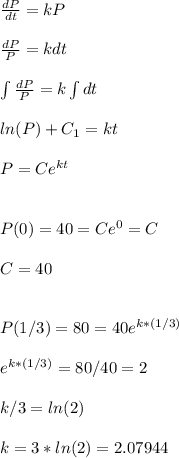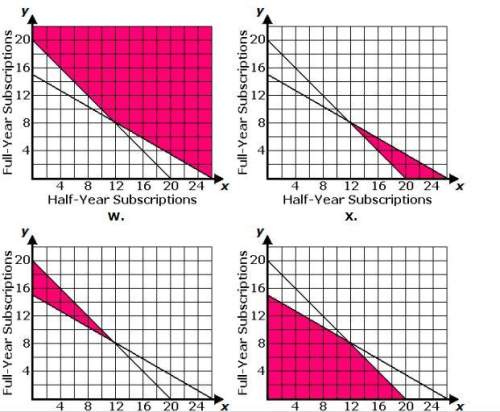
Mathematics, 17.03.2020 04:34 HernanJe6
A common inhabitant of human intestines is the bacterium Escherichia coli, named after the German pediatrician Theodor Escherich, who identified it in 1885. A cell of this bacterium in a nutrient-broth medium divides into two cells every 20 minutes. The initial population of a culture is 40 cells. (a) Find the relative growth rate. k = hr−1 (b) Find an expression for the number of cells after t hours. P(t) = (c) Find the number of cells after 7 hours. cells

Answers: 1


Another question on Mathematics

Mathematics, 21.06.2019 16:00
Correct answer brainliest asap an d 99 pointsss what are relative frequencies to the nearest hundredth of the columns of two way table column a 102, 18 colunm b 34, 14 answers choices 0.15 0.25 0.29 0.44 0.56 0.71 0.75 0.85
Answers: 1


Mathematics, 21.06.2019 18:50
Astudent draws two parabolas on graph paper. both parabolas cross the x-axis at (-4, 0) and (6,0). the y-intercept of thefirst parabola is (0, –12). the y-intercept of the second parabola is (0-24). what is the positive difference between the avalues for the two functions that describe the parabolas? write your answer as a decimal rounded to the nearest tenth.
Answers: 2

Mathematics, 21.06.2019 19:20
Which letters from the table represent like terms? a and b b and c a and d b and d
Answers: 3
You know the right answer?
A common inhabitant of human intestines is the bacterium Escherichia coli, named after the German pe...
Questions

Biology, 05.01.2021 19:30

Mathematics, 05.01.2021 19:30

History, 05.01.2021 19:30






History, 05.01.2021 19:30


Computers and Technology, 05.01.2021 19:30


Mathematics, 05.01.2021 19:30

History, 05.01.2021 19:30

Mathematics, 05.01.2021 19:30


Chemistry, 05.01.2021 19:30

Mathematics, 05.01.2021 19:40


Chemistry, 05.01.2021 19:40







